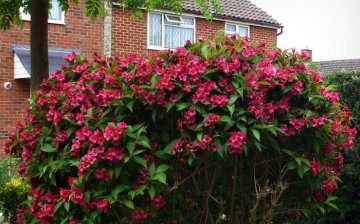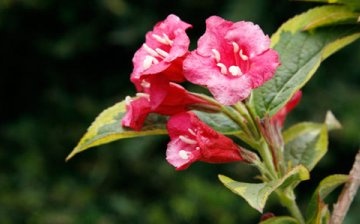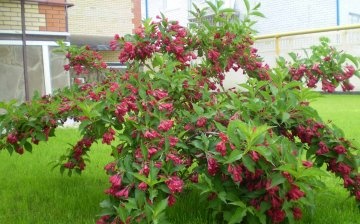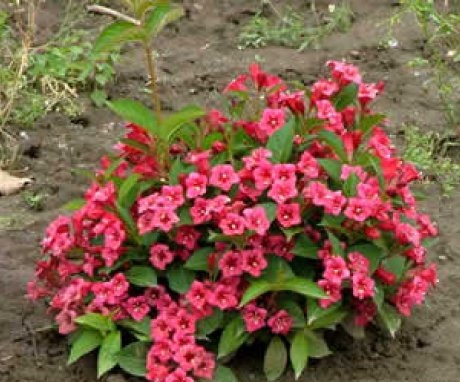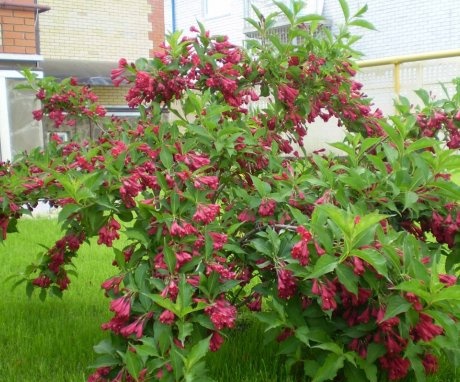Weigela shrub. Reproduction of weigela
So much amazing beauty and quiet joy are given to us by the plants that surround us everywhere. It pleases the eye, delights and surprises with the beautiful, lushly blooming weigela shrub, strewn with tubular bells, sometimes opening until the leaves are completely blooming. Weigela looks good in a sunny meadow surrounded by bushes, in a cozy place protected from drafts and northern winds, but it is undesirable to use it as a hedge.
Content:
- Weigela shrub appearance
- Favorable conditions for growth and development
- Correct care
- Worthy decoration
- Propagation by cuttings
- Other breeding methods
Weigela shrub appearance
This shrub is distinguished by the extraordinary beauty of rather large, up to 5 centimeters of flowers, collected in inflorescences and single, located in the axils of the leaves and on the tops of young shoots. Flower corollas are odorless and come in a wide variety of colors and shades, from white, pink and pale cream to bright reds, purples and scarlet. In this case, the color changes in the process of flowering and wilting.
Sometimes unusual leaves of some varieties of weigela compete with elegant flowers, with a cream edging on a green velvety background, and by autumn the crown becomes a crimson burgundy or bright purple color. In the countries of East Asia, one and a half dozen species of this amazing herbaceous perennial are widespread. It is also familiar to gardeners of the Far East, and in central Russia, weigela is a deciduous shrub about two meters high.
Favorable conditions for growth and development
Weigela is a rather capricious plant that needs careful care and increased attention. The shrub often freezes slightly, but quickly recovers, and it is still better to protect the lower branches by bending them to the ground and sprinkling them with peat in late autumn. The entire shrub can be covered with coniferous spruce branches, and later bury it in a snowdrift.
As they grow older, weigela becomes more resistant to frost, but can die if its roots are flooded with spring melt water. Therefore, even during planting, you need to ensure good drainage, through pebbles, fine gravel, broken brick, and then take care of uniform and regular moisture of the soil, avoiding prolonged drying out, much less stagnation of moisture.
Correct care
Systematic sanitary pruning in the spring it will give the shrub the desired decorative look, relieve the plant of dried, broken, sick and frostbitten twigs. It is also advisable to shorten branches with wilting flowers, which will provoke the appearance of new shoots, on which flowers will appear again.
It should be remembered that late autumn pruning is undesirable, so as not to damage the flower buds of the next season. Decorative pruning is best done during or after flowering. It is noteworthy that cut-off flowering branches of weigela are perfectly preserved for a long time.
Weigela shrub is an abundantly flowering and therefore very decorative deciduous plant. Due to the variety of species, weigela will decorate any corner of the garden and will be a great addition to alpine slides, a Japanese garden, or just a bright spot in the garden.
Worthy decoration
Before planting the weigela, you need to find a suitable place for it in the garden. Most species of weigela are thermophilic, so it is necessary to take into account the winter hardiness of the species you have chosen.The weigela shrub has the ability to increase its winter hardiness over time and, even after frost damage, is able to bloom in the same year, and weigela can bloom several times per season.
Many types of weigela are decorative not only for their tubular bell-shaped flowers, but also for their foliage, which can be velvety, have a green, purple color, or a white border around the edge of a green leaf.
Weigela does not require special care, it is better to plant it in a loose, fertile and sufficiently moisturized soil, the landing site should be protected from cold winds, sun or partial shade. Winter-hardy shrub varieties do not need to be covered for the winter. To improve the appearance of the shrub, it should be trimmed periodically so that the branches become more branched.
Propagation by cuttings
The best and easiest way to breed weigela is grafting, with summer cuttings being more preferable. To do this, in the period June-July, it is necessary to cut from young shoots, the thickness of which is at least 0.5 centimeters, cuttings about twenty centimeters long. The cuttings should be held for about six hours in a growth stimulator, remove the lower leaves and then plant them in partial shade, buried ten centimeters in nutritious, loose soil. The soil must be moist, so you need to arrange regular watering and after rooting the cuttings they can be planted in a permanent place in the spring.
Summer green cuttings root much more actively, but weigelu can also be propagated by winter woody cuttings, which are harvested in late autumn. Cuttings are planted in boxes filled with a mixture of nutrient soil and river sand, sprinkled with sand on top. Placed in greenhouses or greenhouses covered with plastic wrap, cuttings need diffused light and high humidity.
Other breeding methods
Weigela reproduces well by dividing the bush and layering, as well as by seeds that are harvested after flowering - this is a fruit with an oblong bivalve seed box. It takes about five years from sowing the seeds to the flowering of the shrub, so this method has not become widespread, in addition, the seeds often do not have time to ripen and lose their germination in the second year.
But if there is such a desire, the seeds can be sown superficially into fertile soil with sand, pressing tightly on top with glass. Thanks to regular careful watering, shoots will appear in 20 days. They are grown like any other seedlings, planted in the soil and looked after, paying maximum attention.
Under favorable conditions, the weigela shrub can live for about thirty years, annually pleasing with its elegant flowering.



